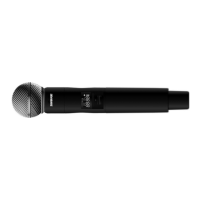
Do you have a question about the Shure QLXD2 and is the answer not in the manual?
| RF power | 1.1 mW |
|---|---|
| Form factor | Handheld transmitter |
| Antenna type | Built-in |
| Display type | LCD |
| Compatibility | Shure QLXD4 Digital Wireless Receiver |
| Product color | Black |
| Average latency | 2.9 ms |
| Built-in display | Yes |
| Housing material | Metal |
| Security algorithms | 256-bit AES |
| Maximum outdoor range | 100 m |
| Operating frequency type | Ultra High Frequency (UHF) |
| Radio Frequency (RF) range | 606 - 670 MHz |
| Operating temperature (T-T) | 18 - 50 °C |
| Microphone frequency response | 30 - 20000 Hz |
| Total Harmonic Distortion (THD) | 0.1 % |
| Width | 51 mm |
|---|---|
| Height | 256 mm |
| Weight | 347 g |
Essential safety guidelines for operating the apparatus to prevent hazards and damage.
Defines the various safety symbols used throughout the manual.
Details on licensing requirements, FCC compliance, and user responsibilities.
Highlights key features and provides a general overview of the QLX-D system.
Lists the main components included with the QLX-D wireless system.
Describes different model variations available to meet specific performance situations.
Initial steps for connecting power and antennas to the receiver.
Procedure for using the receiver's scan function to find the best available channel.
Instructions for installing AA or Shure SB900 batteries into the transmitter.
Procedure for synchronizing the transmitter and receiver to create an audio channel.
Steps for performing a sound check and adjusting audio gain levels.
Guidance on how to properly attach and wear the bodypack transmitter.
Detailed description of the receiver's front panel buttons, display, and LEDs.
Explanation of the receiver's rear panel ports, including power, network, and audio outputs.
Explanation of the icons and indicators shown on the receiver display.
Guide to accessing and navigating the receiver's main and advanced menu screens.
Overview of transmitter parts, including display, buttons, and battery compartment.
How to access and navigate the transmitter's menu options.
Settings for RF power output and mic offset for level matching.
How to set the transmitter's battery type for accurate runtime display.
Methods for locking receiver controls to prevent accidental adjustments.
Procedure for locking and unlocking transmitter controls to prevent unintended changes.
Instructions for battery installation, type selection, and charging procedures.
Configuring low battery alerts and adjusting receiver gain for optimal audio.
Explanation of AES-256 encryption for securing audio signals.
Steps to establish a secure audio channel using encryption and IR sync.
Methods for tuning receivers and transmitters to form audio channels.
Automated frequency assignment for networked receivers.
Manually assigning groups and channels for creating audio channels.
Adjusting transmitter power levels (Lo/Hi) to control RF range.
Information on compatibility with other systems and setting regional TV channel spacing.
Steps for connecting to a network and configuring IP addresses.
Tips for diagnosing and resolving network connectivity issues.
Managing the system using Wireless Workbench software and the ShurePlus Channels app.
Procedures for downloading and updating firmware for receivers and transmitters.
Guidance on resolving common problems like no sound or distortion.
Table listing error codes and their corresponding solutions for system issues.
Instructions for rackmount assembly and securing the AC power cord.
Details on installing footpads and understanding receiver output connector configurations.
A comprehensive list of optional accessories available for the QLX-D system.
Technical details on RF range, tuning step, image rejection, and latency.
Specifications for audio response, dynamic range, distortion, and operating temperatures.
Physical dimensions, power requirements, and RF input specifications for the QLXD4.
Details on audio output configuration, impedance, and levels.
Specifications for networking, audio input, and RF output of the QLXD1 transmitter.
Details on the QLXD2's RF output, input, and modulation type.
Table detailing frequency ranges and corresponding transmitter output power levels.
Frequency availability for the G51 band across different European countries.
Frequency availability for K51 and L52 bands across European countries.
Frequency availability for P51 and Q51 bands across European countries.
Statements regarding compliance with Canadian and European directives.
Declarations of conformity with FCC Part 15 and IEC 60065 electrical safety.